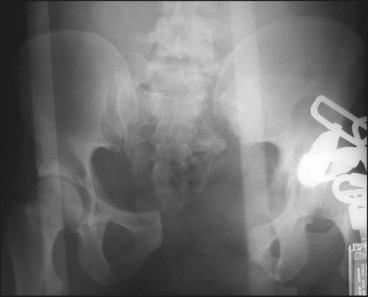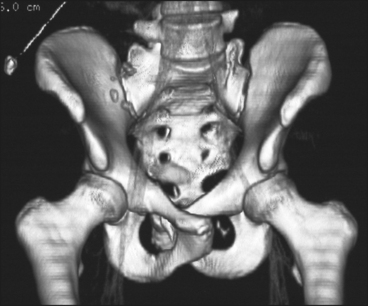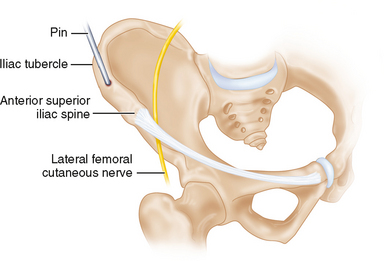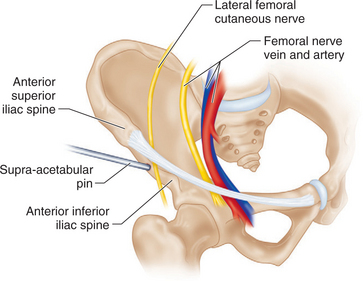PROCEDURE 40 Pelvic External Fixation
Indications
 Temporary stabilization of pelvis fractures in hemodynamically unstable patients as part of resuscitation
Temporary stabilization of pelvis fractures in hemodynamically unstable patients as part of resuscitation Stabilization of pelvis fractures in polytrauma patients to relieve pain and allow early mobilization to an upright position
Stabilization of pelvis fractures in polytrauma patients to relieve pain and allow early mobilization to an upright position Definitive treatment of the anterior pelvic ring in type C injuries for instability following posterior internal fixation
Definitive treatment of the anterior pelvic ring in type C injuries for instability following posterior internal fixationExamination/Imaging
• Will a sheet/binder work as well as external fixation in the unstable patient and be quicker and easier to apply?
• Pelvic sheeting/binder in hemodynamically unstable patients with external rotation and vertically unstable fractures
• Internally rotating and strapping together the lower extremities in hemodynamically unstable patients with external rotation and vertically unstable fractures
• Pelvis C clamp in hemodynamically unstable patients with external rotation and vertically unstable fractures
• Open reduction and internal fixation or percutaneous fixation of pubic rami fractures and/or symphyseal diastasis as definitive treatment of the anterior pelvis injury
 Gentle physical examination is performed to determine internal/external rotational instability and vertical instability.
Gentle physical examination is performed to determine internal/external rotational instability and vertical instability. The patient is assessed for associated urologic, bowel, or acetabular injuries to guide choice of external fixation.
The patient is assessed for associated urologic, bowel, or acetabular injuries to guide choice of external fixation. An anteroposterior (AP) pelvis radiograph is usually sufficient in hemodynamically unstable patients.
An anteroposterior (AP) pelvis radiograph is usually sufficient in hemodynamically unstable patients.• Figure 1 shows a vertically unstable fracture (type C2) in a hemodynamically unstable polytrauma patient (Case 1).
 A computed tomography scan with or without inlet and outlet pelvic radiographs is used to determine definitive treatment.
A computed tomography scan with or without inlet and outlet pelvic radiographs is used to determine definitive treatment.Surgical Anatomy
 Pin placement in the iliac crest insertion between the anterior superior iliac spine (ASIS) and iliac tubercle (Fig. 4)
Pin placement in the iliac crest insertion between the anterior superior iliac spine (ASIS) and iliac tubercle (Fig. 4)• The curvature of the crest and obliquity of the ilium must be taken into consideration so that the pins converge in the dense bone proximal to the acetabulum.
 Supra-acetabular (anterior) pin placement between the ASIS and anterior inferior iliac spine (AIIS) (Fig. 5)
Supra-acetabular (anterior) pin placement between the ASIS and anterior inferior iliac spine (AIIS) (Fig. 5)












